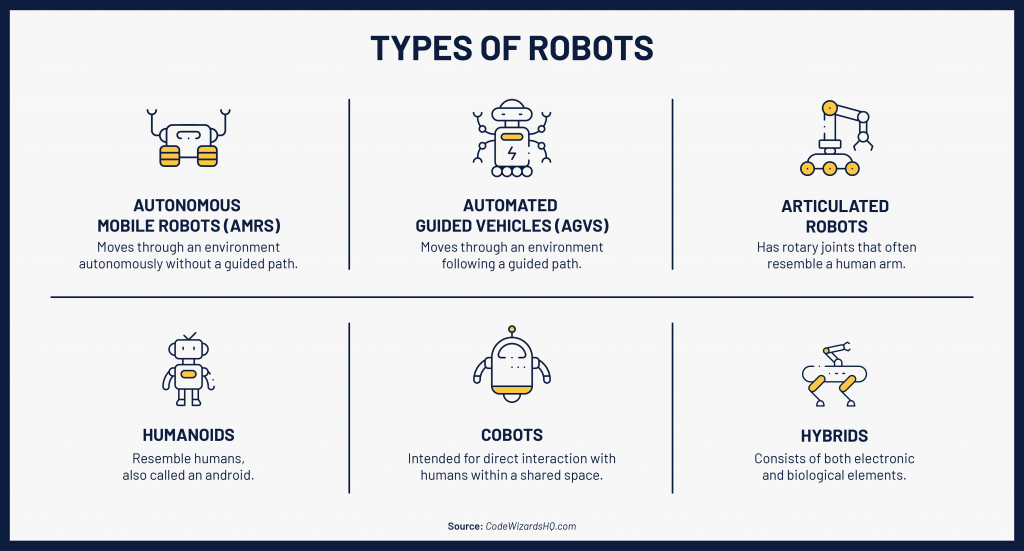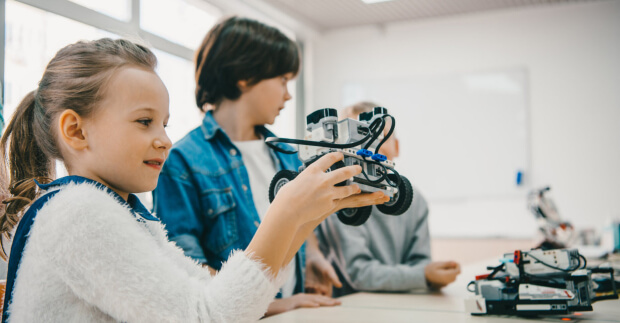Robotics for kids is a fun and hands-on way to introduce them to coding, engineering, and STEM.
Technology is no longer an optional part of education. Engineering and programming knowledge are crucial for many jobs including robotics. Just as it happens, learning about robotics covers both of those areas.
We’ll cover the basics of robotics and give you helpful resources to get your child started in robotics and pursue their interest in technology. When your child is ready to level up their robotics skills, join our top-rated python classes for kids.
Robotics for Kids
- What is a robot?
- How do you explain robotics to kids?
- What age should kids start robotics?
- What are the benefits of robotics for kids?
- How do you teach kids robotics?
- Robotics Classes for Kids
- Robotics Projects for Kids
- Robotics Clubs
- Robotics Camp for Kids
- DIY Robotics Kits for Kids
- 5 Robotics Kits for Kids & Beginners
- Learn Python Programming
What is a robot?
A robot is a machine that is programmed to carry out a range of tasks automatically.
When you think of robots, you might imagine something like Wall-E: a mechanical being with human traits, such as eyes or hands. But a robot can be any complex machine programmed for a task, for example, a mechanical arm that performs open heart surgery is a robot.
Generally, a robot can sense its environment, process information, and act upon its surroundings to accomplish specific goals. These goals can be industrial tasks like assembling products on an assembly line to more complex actions like exploring distant planets or assisting with surgeries.
Robots come in various forms, from simple and stationary to highly complex and mobile. They can also be programmed to perform a wide range of functions depending on their design and capabilities.
Every robot requires a power source, controller, sensors (internal and external), actuators (like motors for movement), and computer code or software.
The most common types of robots, according to Intel, are:
- Autonomous Mobile Robots (AMRs). These robots can move through an environment autonomously without a guided path.
- Automated Guided Vehicles (AGVs). These are a type of AMR that follow a specific path which can be marked by marked long lines or wires on the floor or use radio waves, vision cameras, magnets, or lasers for navigation.
- Articulated Robots. These are robots with rotary joints that often resemble a human arm.
- Humanoids. These are robots that resemble humans, sometimes called an android.
- Cobots. These are collaborative robots which are intended for direct interaction with humans within a shared space.
- Hybrids. These are robots constructed from organic and artificial materials, so it consists of both electronic and biological elements.
Robots are becoming more commonplace than ever and current projections show that by 2030, the global stock of robots will reach 20 million.

How do you explain robotics to kids?
Robotics is the field of designing, building, and operating robots.
Kids are likely to be familiar with a few robots. You can explain robotics to kids using popular examples from TV shows and movies. For example, R2-D2 from Star Wars or Optimus Prime from Transformers. This is a relatable and engaging way to get them interested in learning more about robots.
Explain that robots are smart machines that can move around and do things all on their own. They can look like a human, an animal, or just a machine. They can have eyes (sensors) to see what’s around them, a brain (computer) to think and make decisions, and arms or wheels (actuators) to do things like picking up toys, cleaning the floor, or even playing games! In robotics, engineers and programmers build the robots and program their brains.
Because of the many parts of a robot, robotics for kids can encompass many fields. For example:
- Programming. Coding is a crucial component of controlling the actions or reactions of a robot. Robotics allows kids to gain hands-on experience with programming beyond a classroom environment. Programming a robot and watching it perform tasks in response helps any kid understand the power of coding.
- Design. What’s the most optimized build for a robot that needs to report on the weather? How about one that needs to avoid objects in a room while moving? Design is a major factor in creating a helpful robot, and will teach kids the importance of both form and function.
- Engineering. The basics of mechanical and electrical engineering are crucial when it comes to robotics. While mechanical focuses on structure, movement, and integrity, electrical engineering is necessary for the electrical components that allow for control over the robot.
- Applied Mathematics. From following or creating formulas to taking measurements, calculations are a major part of robotics. No matter your kid’s math skills, they will improve through building a robot.
What age should kids start robotics?
Any kid who has the curiosity to learn about robotics can get involved in learning. With that in mind, the best age for kids robotics is 8 to 14.
By 8 years old, most kids should have the motor skills necessary to explore robotics in a fun and educational way. Learning how to assemble or program a robot at a young age helps exercise their critical thinking abilities and hone creativity when it comes to problem-solving.
The NIH (National Institute of Health) says, “Research has determined that incorporating educational robotics into young children’s educational experiences leads to significant improvement in their engineering and technological conceptual understanding and assists them in engaging in computational thinking and in developing their technology understanding.”
Here’s a suggested path for kids to learn robotics:
8-10 Year Olds – Introduction to Basic Concepts:
- Start by introducing basic concepts of robotics through hands-on activities and simple projects.
- Use age-appropriate books, videos, and online resources to explain concepts like sensors, actuators, programming, and simple machines.
- Encourage exploration with robotics kits designed for beginners, such as LEGO Spoke Essentials or Makeblock mBot, which provide a user-friendly introduction to building and programming robots.
10-12 Year Olds – Programming Fundamentals:
- Introduce kids to programming languages commonly used in robotics, such as Scratch, Blockly, or Python, through interactive games and coding challenges.
- Explore programming concepts like sequencing, loops, conditionals, and variables in the context of robotics projects.
- Encourage experimentation with programmable robots that allow kids to write and execute their own code to control the robot’s behavior.
12-14 Year Olds – Hands-On Building and Design:
- Provide opportunities for kids to design, build, and modify their own robots using robotics kits and materials.
- Explore principles of engineering and design through challenges like building a robot that can navigate a maze, perform a specific task, or compete in a robot competition.
- Encourage creativity and problem-solving skills by allowing kids to brainstorm ideas, prototype designs, and iterate based on feedback.
14+ Year Olds – Advanced Topics and Specializations:
- Introduce more advanced topics in robotics for teens, such as sensors and feedback systems, artificial intelligence, computer vision, and machine learning.
- Provide opportunities for kids to explore specialized areas of interest within robotics, such as robotics in healthcare, space exploration, environmental monitoring, or autonomous vehicles.
- Encourage participation in robotics competitions, clubs, or summer camps to further develop skills, collaborate with peers, and apply knowledge in real-world scenarios.

Get latest in kids coding
activities, news, and resources!
Newsletter Sign Up
"*" indicates required fields
What are the benefits of robotics for kids?
Research has shown that learning robotics offers several benefits for kids across various cognitive, social, and academic domains.
Here are some key benefits of robotics for kids supported by research:
- STEM Skills Development: Learning robotics helps kids develop skills in science, technology, engineering, and mathematics (STEM). Through hands-on activities and projects, they gain practical knowledge in areas such as programming, electronics, mechanics, and problem-solving.
- Critical Thinking and Problem-Solving: Robotics challenges kids to think critically and solve complex problems. They learn to analyze tasks, break them down into smaller steps, and develop strategies to achieve goals, fostering cognitive skills essential for success in school and life.
- Creativity and Innovation: Robotics encourages creativity and innovation as kids design, build, and program their own robots. They learn to think outside the box, experiment with different ideas, and iterate on designs, fostering a mindset of innovation and entrepreneurship.
- Collaboration and Communication: Working on robotics projects often involves collaboration with peers, promoting teamwork, communication, and interpersonal skills. Kids learn to share ideas, listen to others, and work together to achieve common goals, essential skills for success in the workplace and society.
- Persistence and Resilience: Robotics projects can be challenging, requiring perseverance and resilience to overcome obstacles and setbacks. Through trial and error, kids learn the value of persistence, adaptability, and learning from failure, building important life skills that contribute to academic and personal success.
- Real-World Relevance: Robotics provides a tangible context for learning, helping kids see the real-world applications of STEM concepts. They gain a deeper understanding of how technology impacts everyday life and explore potential career pathways in STEM fields, motivating them to pursue further education and training.
- Interest and Engagement in STEM: Research suggests that engaging kids in robotics can increase their interest and motivation in STEM subjects. By making learning fun, hands-on, and relevant to their interests and experiences, robotics helps foster a positive attitude towards STEM learning and careers.
Studying robotics will not only open up a whole world of knowledge to your child but also give them tools that will help them succeed in any other field they might pick. Learning robotics will help them develop essential skills and competencies that are valuable for academic success, future careers, and lifelong learning.
How do you teach kids robotics?
There are many options in robotics for kids to choose from based on your child’s age, experience, and interest. Many students start at home with simple projects and kits before advancing to coding or robotics classes.
Robotics Classes for Kids
Structured learning environments are a great option for many kids. A qualified instructor can guide learning, support students if they’re struggling, and provide the right equipment for new engineers. Playto is a popular option for live 1-1 online robotics classes.
Robotics Projects for Kids
Robotics projects are a way for kids to jump right in with hands-on activities or tasks. These projects vary in complexity and can range from simple introductory exercises to more advanced challenges. Raspberry Pi has a list of free robotics projects where kids can learn using their hardware and popular software.
Robotics Clubs
Whether it’s at school or part of an outside organization, a robotics club gets kids involved in projects for solid hands-on experience, fostering a teamwork environment. Clubs are also a way to join competitions against other schools or teams.
Robotics Camp for Kids
Summer is the perfect time for kids to explore extracurricular interests. Students can join robotics camps for guided, active learning. They’ll be able to dive in and learn quickly through a dedicated camp. NASA has a list of summer robotics and STEM camps that kids can attend.
DIY Robotics Kits for Kids
Purchasing a robotics kit can jumpstart your kid’s learning at home in their free time. If your child is a self-starter who learns well through hands-on experience, kits could be the beginning of their robotics journey.
Ultimately, the best way to teach kids robotics depends on the kid. Robotic kits are a great way to test out how much your child enjoys working with robots at home, especially for younger kids who might not qualify for advanced robotics yet. If they’re older and ready to invest more time in larger projects or even competitions, clubs or courses might be the better way to go.

5 Robotics Kits for Kids & Beginners
Want to give your kid a sense of robotics before investing in classes or club activities? Here are some robotics kits for kids and beginners to start with.
1. Lego Mindstorms EV3 31313 Robot Kit
With 601 pieces and 17 different possible robot designs to build, this Lego robot kit can talk, play games, shoot targets, and more. It’s also fully compatible with other Lego construction sets if you want to get creative. The drag-and-drop coding interface should be intuitive for kids ages 10 and up.
2. Ubtech Jimu Astrobot Series: Cosmo Kit
For space lovers, the Cosmos Kit has three different robot builds, complete with sensors, to inspire the imagination. You can program the robot via the Blockly coding platform, which allows for coding with Scratch, a common language for beginners. Jimu recommends this kit for ages 8-12.
3. 4M Tin Can Robot
Want a robot that won’t break the bank? This kit provides detailed instructions along with motors, hands, googly eyes, and more that you need to put together an adorable robot on the move. All you need to add is the tin can. This is one of the simpler options in terms of robot capability, but it’s great for anyone looking to gauge robotics interest on a budget. This robot is best for kids over the age of 9 or up.
4. 4M Kidzlabs Robotic Hand Kit.
Looking to practice building without too many bells and whistles? This robotic hand kit comes with detailed assembly instructions perfect for beginners, and the fingers grip when you pull the cords. It’s an affordable option for trying out the building aspect if your kid loves to play hands-on. Recommended for ages 8 or up.
5. Thames and Kosmos Remote Control Machines
This remote control kit allows kids to practice building ten different motorized vehicles and machines. (Creative builders might be able to create even more!) It’s notable for a unique infrared remote control that can control three motors at once, opening up the possibility for more complex multi-motor machines. Manufacturers recommend this kit for kids age 8 and up.
Learn Python Programming
If you’re looking for an activity that will hone your kid’s problem-solving skills and teach them the foundations of mathematics, engineering, and programming, robotics is a good fit.
Once you’ve moved beyond the beginner robotics kits, learning Python programming will help you advance your robotics skills. Check out CodeWizardsHQ’s python classes for kids, designed to provide kids with the tools, knowledge, and confidence to thrive in today’s digital world. Enroll to get started.
